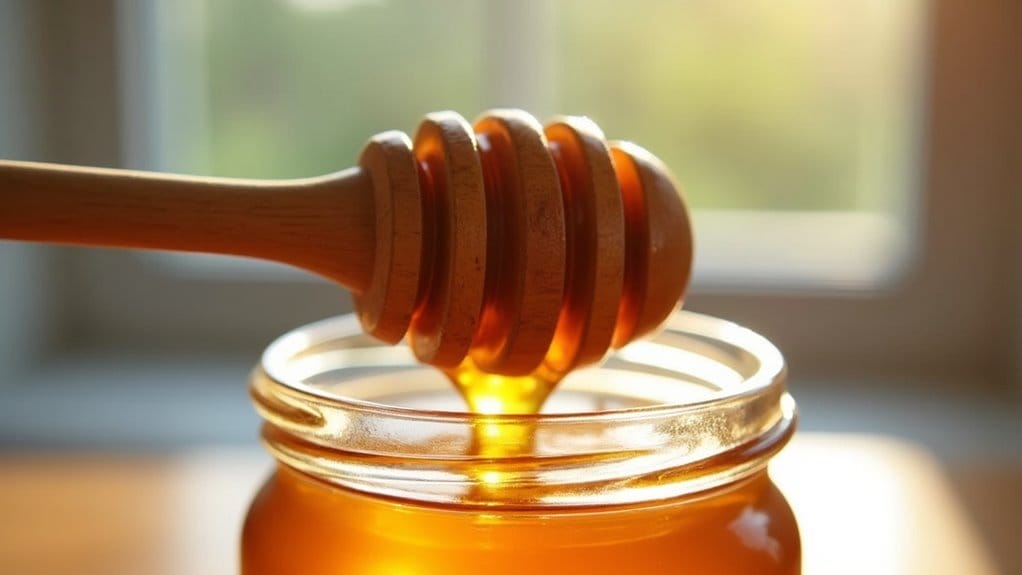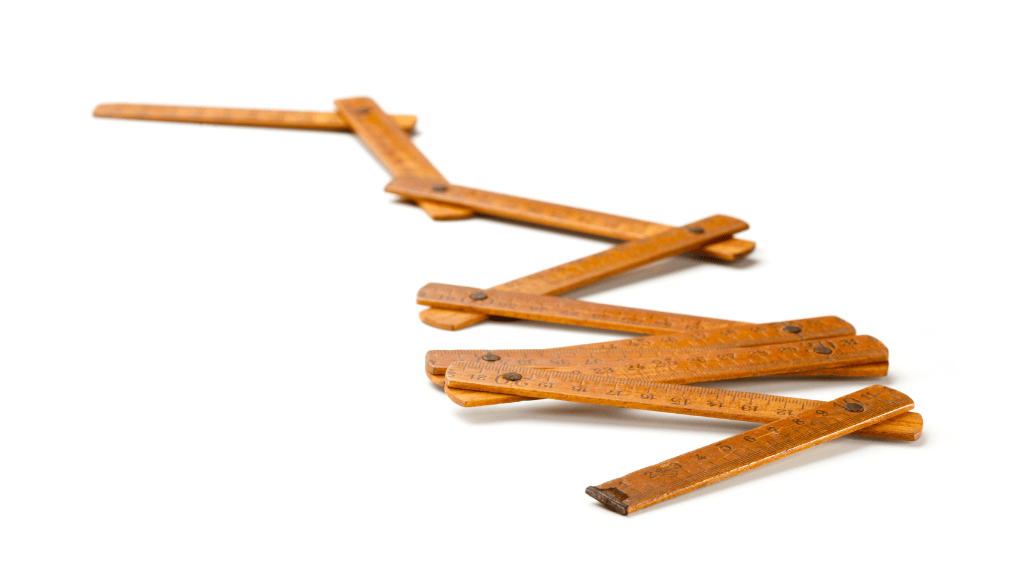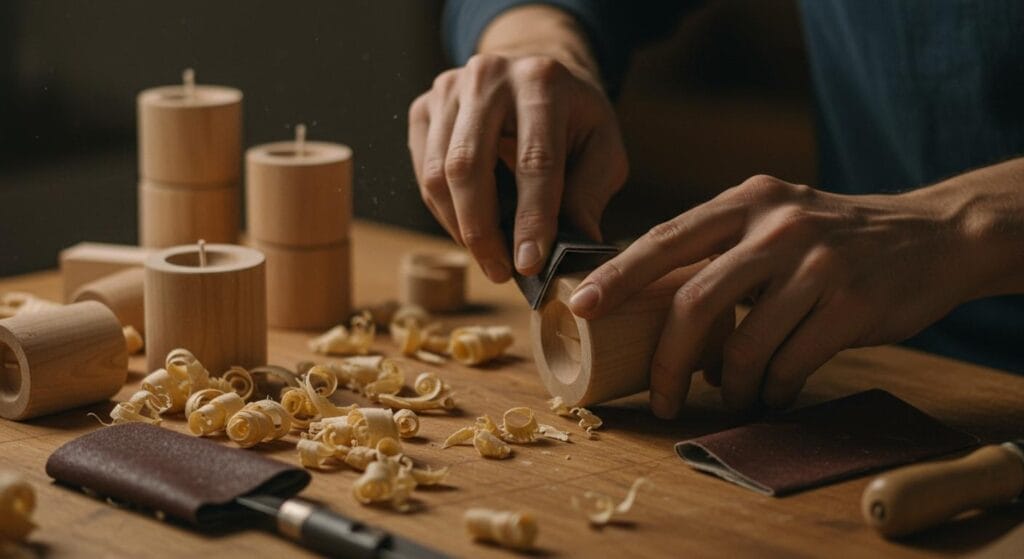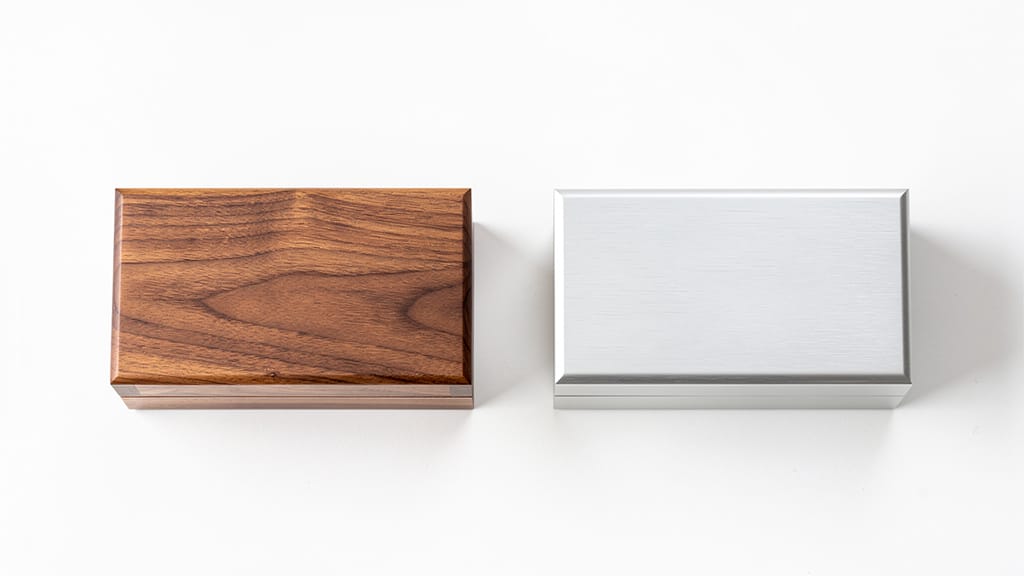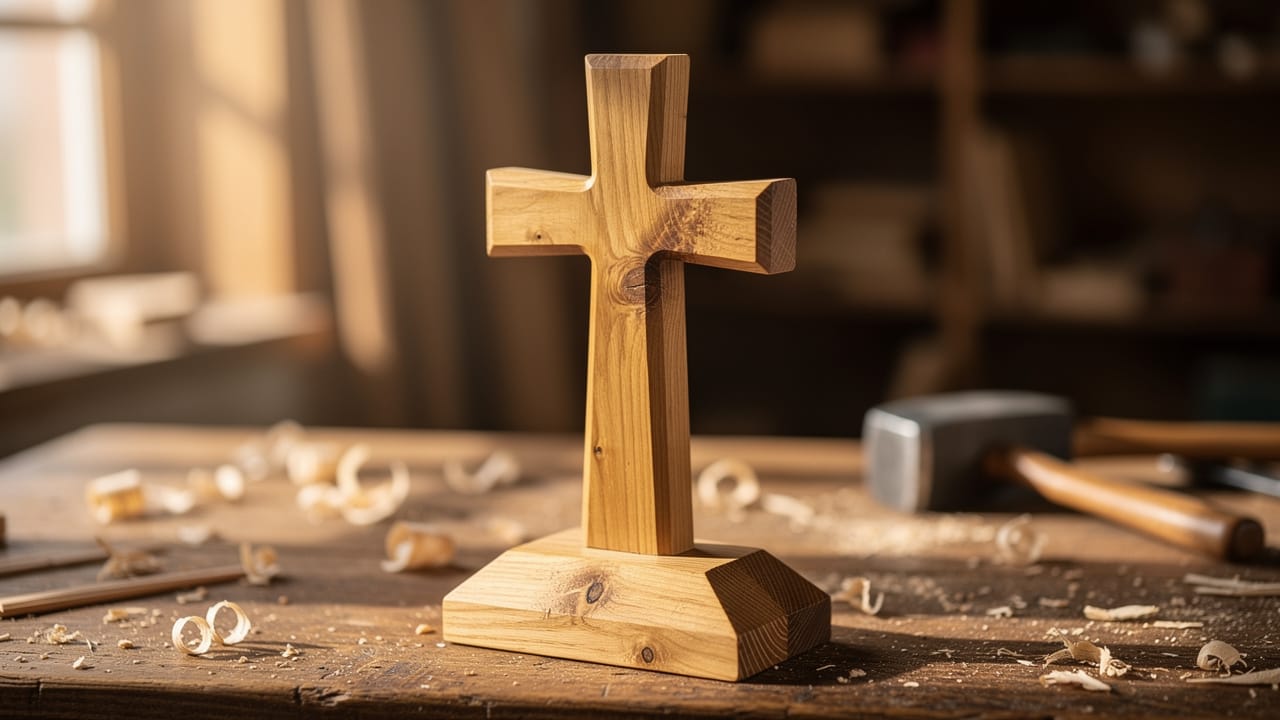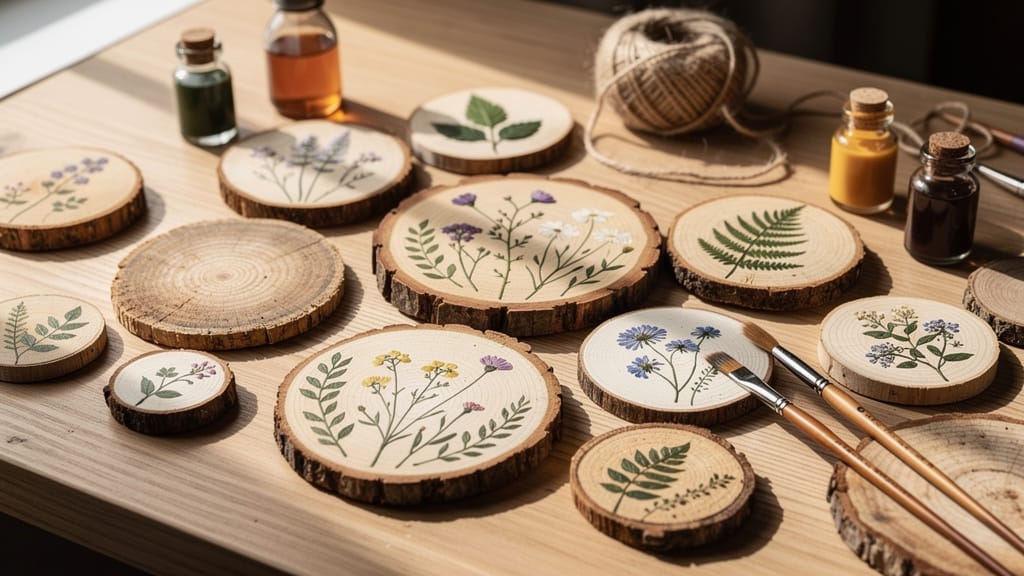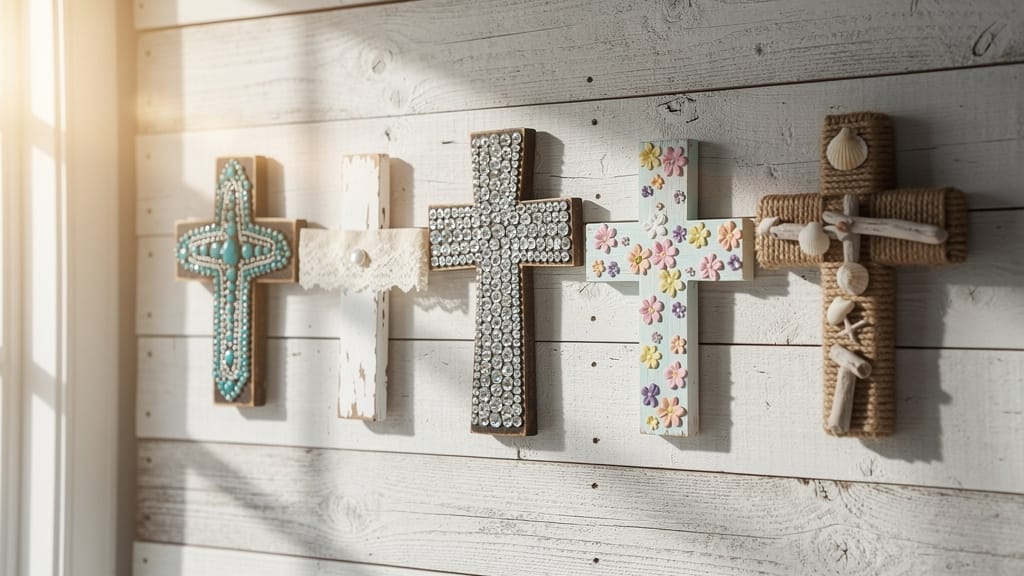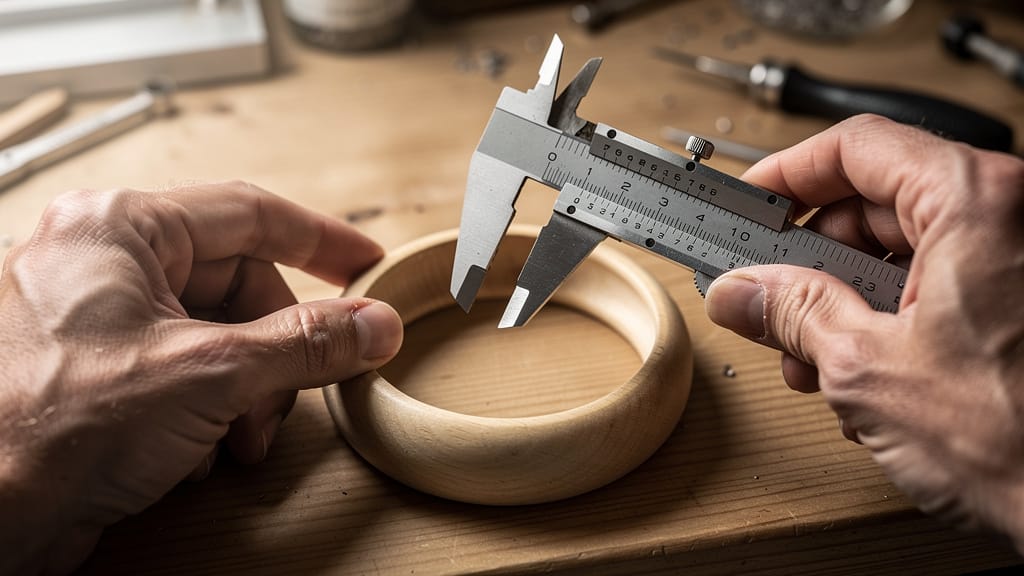Why are honey dippers made of wood? Wooden honey dippers are your best choice because wood’s natural antibacterial properties help preserve the purity of honey while resisting absorption and chemical reactions.
Wood’s grooves and ovoid shape provide superior control over honey flow, making drizzling precise and mess-free. Unlike metal or plastic alternatives, wooden dippers won’t corrode or leach unwanted flavors into your honey.
The sustainable, eco-friendly nature of wooden dippers reveals just the beginning of their remarkable advantages.
Key Takeaways: Why Are Honey Dippers Made of Wood?
- Wood’s natural antibacterial properties prevent bacterial growth, maintaining the purity of honey during storage and serving.
- Wooden dippers are cost-effective compared to materials like metal or ivory. This makes them accessible and practical.
- Wood doesn’t react with honey. This ensures no unwanted flavors or chemical leaching occur during use.
- The natural texture and grain of wood create ideal grooves for controlling honey flow and preventing messy drips.
- Wood is an environmentally sustainable and biodegradable material. It requires less energy to produce than synthetic materials.
A Brief History of the Honey Dipper

The humble honey dipper’s history spans hundreds of years, rooted in the practical needs of kitchens worldwide.
The wooden dipper emerged as craftsmen recognized wood’s natural availability and antibacterial properties, making it ideal for handling honey.
The history of honey dippers reflects an evolution driven by functionality, as artisans developed shapes that could effectively manage honey’s unique viscosity.
While more expensive materials, such as ivory and metals, were available, wood remained the superior choice.
Its safety for food contact, combined with traditional woodworking techniques, established it as the cornerstone material for these essential kitchen tools.
Functional Design: How a Honey Dipper Works
Building upon centuries of woodworking innovation, modern honey dippers showcase an ingenious design. This design maximizes their effectiveness through precise engineering.
When you use a honey dipper, you’ll notice its functional design features, lateral grooves, and an ovoid shape that work together to control honey flow. Unlike spoons, these grooves create a slow-flowing boundary layer that traps and holds the viscous honey.
The dipper’s specialized shape lets you drizzle honey with precision, utilizing surface tension rather than gravity. The carefully crafted design guarantees you can transfer honey efficiently while maintaining control and minimizing mess.
Why Wood Is a Popular Material for Honey Dippers?

Crafted from nature’s timeless material, wood stands out as an ideal choice for honey dippers. This is due to its combination of practicality and charm.
Wooden honey dippers offer exceptional functionality through their natural grooves and ovoid shape. They help retain and control the honey flow in the honey pot perfectly.
Wood’s cost-effectiveness makes it an accessible alternative to expensive materials. Meanwhile, its warm aesthetic appeal can be enhanced with decorative carvings.
Wood brings both affordability and beauty to honey dippers, offering an eco-friendly option that can be artfully enhanced through carving.
Unlike metal alternatives, wood won’t corrode or react with honey, preserving its pure flavor.
With proper care, these dippers will serve you reliably for years. This makes them both sustainable and practical.
Hygienic Considerations: Is Wood Safe for Honey?
Many might question whether wood is a suitable material for honey utensils. Scientific evidence confirms its safety and natural antibacterial properties.
When you choose a wooden honey dipper, you’re selecting a tool that naturally inhibits bacterial growth while preserving your honey’s authentic taste and aroma.
Your hygienic considerations are well-addressed with wood. Because it won’t corrode or react chemically with honey like some metals might.
With proper cleaning and maintenance, you’ll find that wooden honey dippers resist absorption of honey residue, maintaining food safety standards.
This makes wood not only a traditional choice but also a scientifically sound one for honey handling.
Comparison: Wood vs. Other Materials

When choosing a honey dipper, you’ll discover significant differences between wooden options and those made from glass, metal, or silicone. Wooden dippers excel through their non-reactive nature. They preserve honey’s pure taste without the use of chemical leaching or metallic flavors. They’re also more durable than glass and safer than plastic dippers.
| Material | Advantages | Disadvantages |
|---|---|---|
| Wood | Natural, flavour‑neutral, durable | Requires proper drying and care |
| Glass | Easy to clean, transparent | Fragile; risk of breakage |
| Metal | Long‑lasting | Possible corrosion; may impart metallic taste |
| Plastic | Affordable | Risk of chemical leaching; less durable |
Environmental Impact: Sustainability of Wooden Honey Dippers
As environmentally conscious consumers seek sustainable kitchen tools, wooden honey dippers stand out as an eco-friendly alternative to plastic and metal options.
When you choose a wooden honey dipper, you’re investing in a renewable resource that supports responsible forestry practices and traditional craftsmanship. These utensils are sourced from managed forests where replanting guarantees ecological balance.
You’ll appreciate that wooden honey dippers are biodegradable. They naturally decompose, eliminating the need to add to landfill waste.
Their production process requires less energy than manufacturing plastic or metal alternatives. This results in a lower carbon footprint. By selecting wood, you’re making a choice that benefits both your kitchen and the environment.
Cultural and Aesthetic Appeal of Wooden Dippers

Since their earliest use in traditional kitchens, wooden honey dipper has captivated users with its natural beauty and cultural significance.
Their warm tones and distinctive grain patterns add artisanal beauty to both functional use and decorative display. These dippers reflect generations of craftsmanship. They often feature customized engravings, making them cherished gifts and family heirlooms.
They’re particularly appealing to those who value sustainability, as their natural origins connect seamlessly with eco-conscious lifestyles.
The rustic charm of wooden dippers enhances your dining experience while celebrating traditional values and environmental responsibility.
How to Choose and Care for a Wooden Honey Dipper
The proper selection and maintenance of your wooden honey dipper will greatly impact its performance and longevity. When choosing, opt for sustainable hardwoods with ovoid shapes and lateral grooves for peak honey control.
You’ll need to care for your dipper consistently to preserve its functionality.
- Always wash the dipper by hand using mild soap and warm water, avoiding dishwashers and prolonged soaking.
- Apply food-safe mineral oil regularly to prevent drying and maintain the wood’s integrity.
- Clean wooden dippers promptly after each use to prevent honey absorption and bacterial growth.
Common Myths and Misconceptions About Wooden Honey Dippers

Misconceptions about wooden honey dippers often stem from outdated beliefs and misinformation.
You’ll hear claims that wood harbors bacteria. But it actually contains natural antimicrobial properties that help prevent bacterial growth.
While some believe wooden honey dippers work less effectively than metal alternatives, they’re just as functional and can last for years with proper maintenance.
Don’t let myths about wood absorption discourage you. Regular cleaning prevents honey buildup, and the material is perfectly food-safe when sourced from appropriate sources.
Far from being plain utensils, wooden honey dippers can showcase beautiful craftsmanship through intricate designs and the natural beauty of wood grains.
Conclusion
Wooden honey dippers remain the ideal choice due to their natural antibacterial properties, sustainable production, and superior functionality. They won’t react with honey’s acids, don’t conduct heat, and maintain the purity of honey.
When properly cared for, your wooden dipper will serve you reliably for years while preserving the traditional craftsmanship and environmental benefits that modern alternatives can’t match.
FAQs
What Is the Purpose of a Wooden Honey Dipper?
Wooden honey dippers feature grooves and ovoid shapes to effectively lift, control, and dispense honey. Their natural material safely absorbs residue and prevents unwanted dripping during use.
What Is the Best Material for a Honey Dipper?
Wood is the best material for honey dippers. It’s food-safe, cost-effective, and naturally handles honey’s viscosity while preserving its taste and providing a traditional aesthetic appeal.
Can You Leave a Wooden Honey Dipper in Honey?
You shouldn’t leave your wooden honey dipper in honey. It’ll absorb excess moisture and potentially harbor bacteria. Instead, remove it after each use, wash it thoroughly, and let it dry completely.
Why Do They Use Wood for Honey?
Wood is ideal for honey tools because it’s food-safe, naturally porous, and provides a better honey grip, while also resisting corrosion and chemical reactions. It’s also cost-effective while adding warmth and charm to your kitchen.

